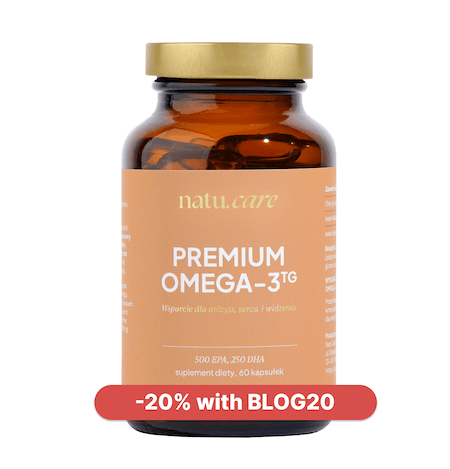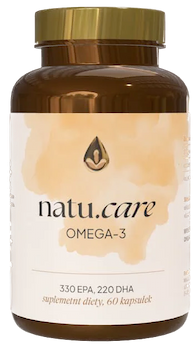- Home
- Omega acids
- ALA (alpha-linolenic acid)
Alpha-linolenic acid (omega-3 ALA): properties and sources
Alpha-linolenic acid is one of the Omega-3 acids, but you won't find it in most supplements.


Learn more about our editorial process
.

Learn more about our editorial process
.

Learn more about our editorial process
.

Learn more about our editorial process
.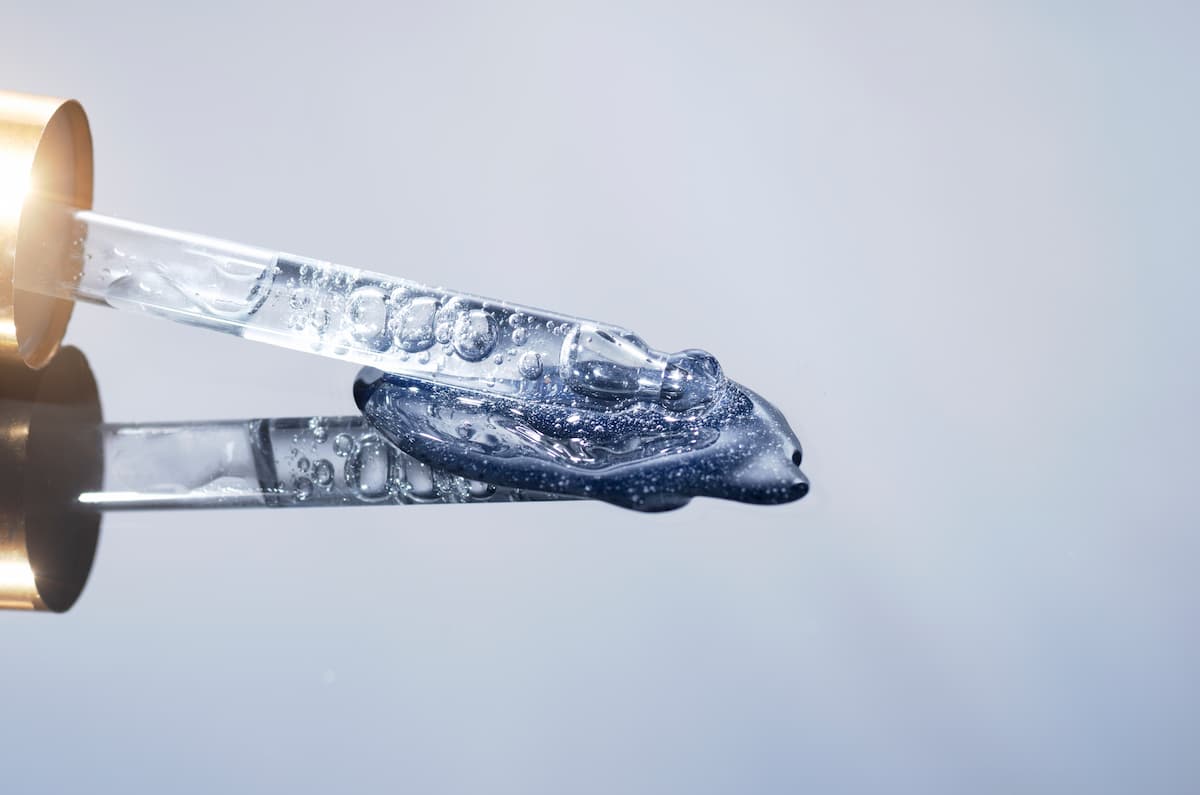
Why you can trust us
Articles on Natu.Care are written based on scientific research, data from government websites and other reliable sources. The texts are written in cooperation with doctors, nutritionists and other health and beauty experts. Articles are reviewed before publication and during significant updates.
.Learn more about our editorial process
.Information about advertisements
Content on Natu.Care may contain links to products from the sale of which we may receive a commission. When creating content, we adhere to high editorial standards and take care to be objective about the products discussed. The presence of affiliate links is not dictated by our partners, and we select the products we review ourselves completely independently.
.Learn more about our terms and Conditions
.Apparently an omega-3, but only two fatty acids everywhere: EPA and DHA. The third of this family is ALA, or alpha-linolenic acid.
If you have ever been troubled as to why manufacturers in dietary supplements separate the triplets and only two of the three main fatty acids are available in most omeg, the general answer is: ALA in the body is converted to EPA and DHA. However, the matter is not quite so simple and obvious.
From this article you will learn:
- What is alpha-linolenic acid.
- What properties does it have?
- What properties it has. .
- Whether ALA on its own can support the body.
- What it does.
- What to eat to provide yourself with this acid. .
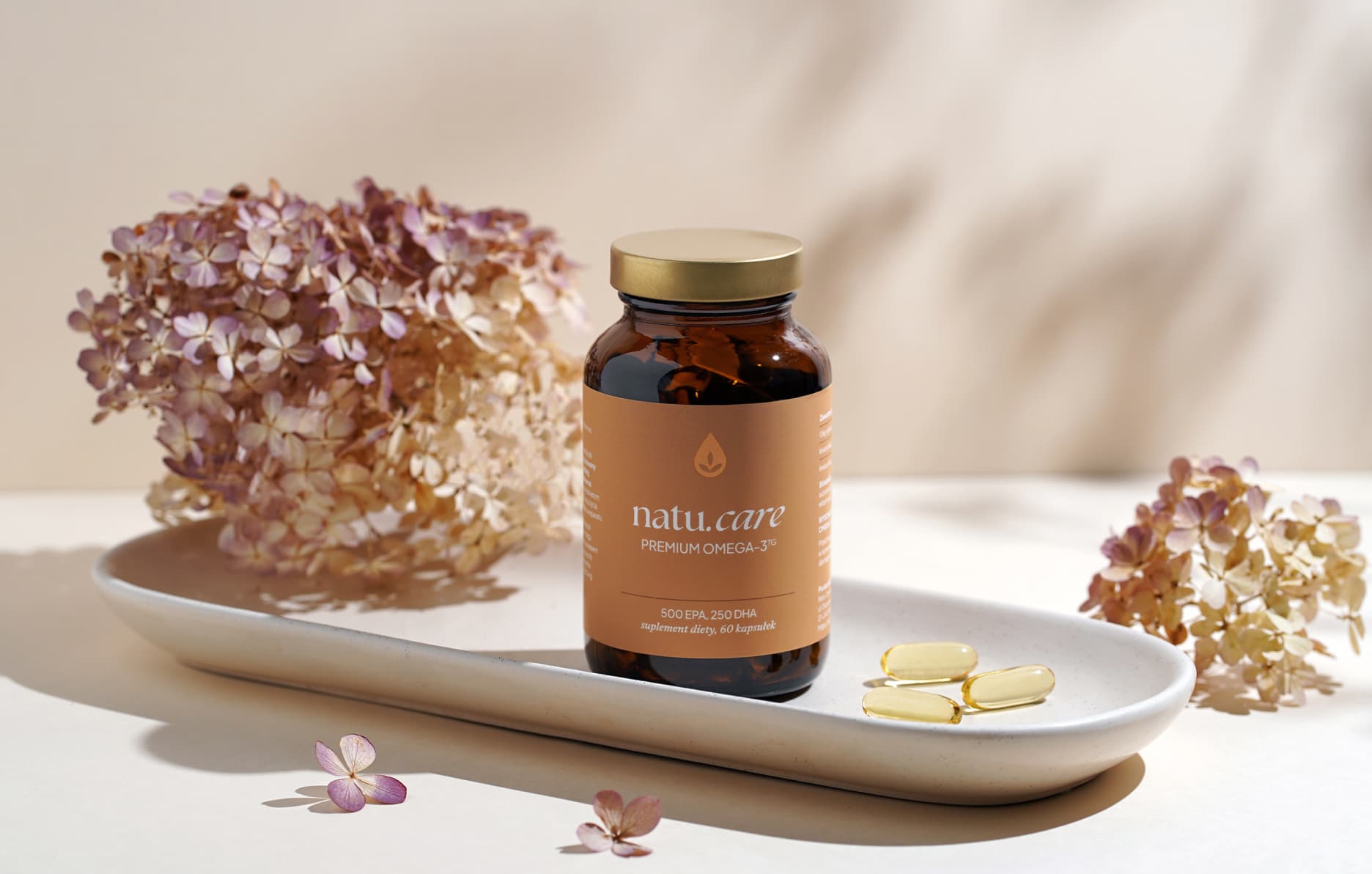
Sprawdź, za co pokochały go tysiące klientek Natu.Care Premium Omega-3ᵀᴳ -15% z kodem BLOG15
Natu.Care Omega-3ᵀᴳ Premium
Natu.Care Omega-3ᵀᴳ Premium dla zdrowia serca, mózgu i odporności. Najlepsza przyswajalność. Optymalna dawka 750 mg. Przebadana przez niezależne laboratorium.
Zobacz więcej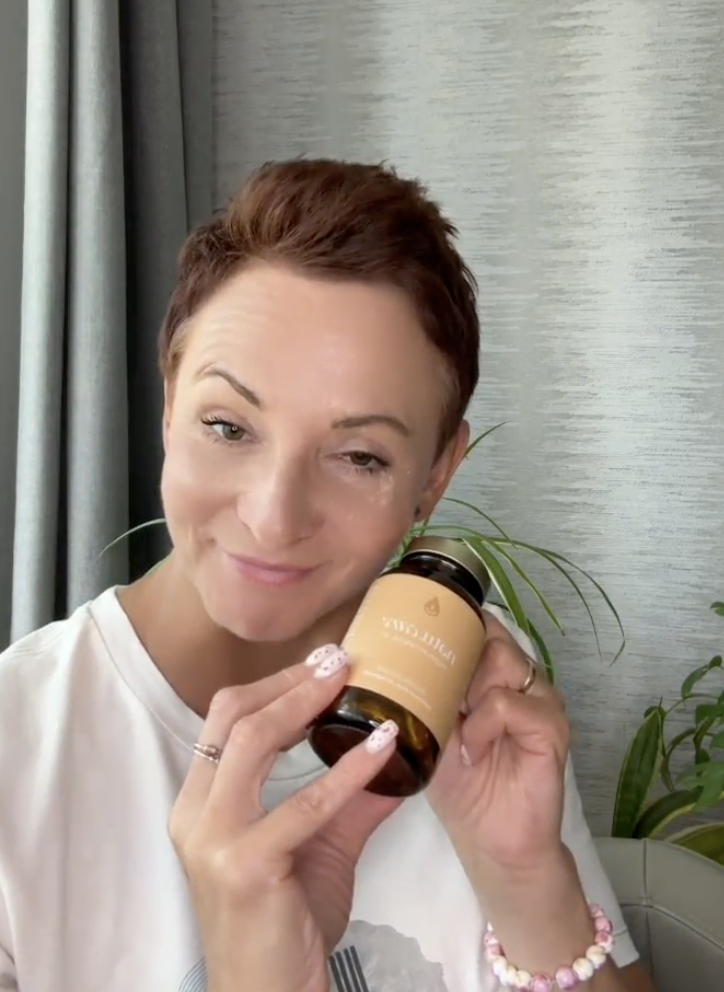
Produkt ma super skład, transparentną etykietę i co dla mnie jest ważne – małe kapsułki do połknięcia. Nie ma też nieprzyjemnego efektu odbijania rybą, który miałam spożywając inne produkty. Widzę znaczną poprawę odporności. Polecam!@Kasia P.
See also:
.- EPA acid
- DHA acid
- Omega-3 fatty acids
- Triglycerides - why are they better than esters? .
- All omega acids
- Everything you need to know about tranium
What is alpha-linolenic acid?
.Alpha-linolenic acid (α-linolenic acid), also known fondly as ALA, along with DHA and EPA, is one of the three main omega-3 fatty acids. It is a polyunsaturated fatty acid (C-18 n-3) with 18 carbon atoms. It is found naturally mainly in vegetable oils, linseed and nutsand.
Important
There are two substances that are referred to as ALA acid: alpha-lipoic acid and alpha-linolenic acid. These are not the same compounds. Alpha-linolenic acid belongs to the omega-3 group of acids, while alpha-lipoic acid is a saturated fatty acid known for its antioxidant properties.
Why is ALA not found in omega-3 supplements?
.Alpha-linolenic acid is quite commonly found in products that we consume in sufficient quantities (e.g. vegetable oils, nuts, seeds). In addition, this compound has the ability to convert in the body into EPA and DHA acids via the metabolite oxylipinand.
It should also be noted that, until recently, the health-promoting properties of EPA and DHA acids were almost exclusively the subject of research, which is why manufacturers of omega-3 preparations mainly include these substances in their formulations.
However, there are at least two ... but to this approach to ALA acid.
Firstly: since ALA is widely available in the products we eat and converts to EPA and DHA then... why supplement it? Why do experts recommend eating fish that are rich in them if you can indirectly obtain them from plant sources (sources of alpha-linolenic acid)? The answer is simple: converting ALA into EPA and DHA is not very efficient and will not meet your need for these fatsand.
Secondly: if alpha-linolenic acid is converted into other omega-3 fatty acids, doesn't it have any properties on its own? It turns out that it does not necessarily, although it is not entirely clear which properties relate to ALA acid itself and which are related to those into which it is converted (especially in terms of the properties of EPA acid)and.
An excess of ALA will interfere with the metabolism of EPA and DHA, reduce the function of the latter, impair their absorption and bioactivity..
 .
.
Julia SkrajdaDietitian
.Properties of alpha-linolenic acid
.Alpha-linolenic acid is metabolised in the body to oxylipins, or (without going into intricate chemical meanderings) other forms of acids. Some of these may show health-promoting benefitsand:
- immunomodulating - influencing the function of the immune system, .
- improving lipid profile - regulating fat metabolism in the body, .
- reducing CRP levels - reducing inflammation, .
- cardioprotective - protecting the cardiovascular system, .
Product description
The dietary supplement contains omega-3ᵀᴳ, or omega-3 acids in the form of trójglyceridesów. Scientific studies suggest that this form of fatty acidsós up to 2 times better absorbed than the estersós present in many dietary supplements on the market. This means that you are assured of their effectiveness and of supplying yourself with valuable omega acids.
Fatty acids omega-3 are derived from wild anchovy oil. It is a rich source of healthy fats that are essential for the health of the cardiovascular, immune and nervous systems, as well as the proper function of vision, joints muscles.
Scientific research suggests that wild anchovies are a good source of healthy fats.
Scientific research also suggests that an adequate intake of omega-3 fatty acidsós protects against and supports the treatment of depression and anxiety disorders. In addition, omega-3s influence the hydration and appearance of the skinóry and support healthy sleep.
.
The formula contains a total of 750 mg of EPA+DHA acidsós, which is three times higher than the recommended minimum of 250 mg for the Polish population. Omega-3 TG Premium has studies indicating that its TOTOX is 9, which is a very good result.
Supplementation of omega-3 fatty acidsóis recommended for anyone who does not eat 1–2 portions (approximately 300 g) of oily fish per week. Children during growth, seniors, physically active people, vegans and vegetarians, as well as patients undergoing cardiovascular treatment and prevention of heart disease also have an increased need.
Pros and cons
The dietary supplement contains omega-3ᵀᴳ, or omega-3 acids in the form of trójglyceridesów. Scientific studies suggest that this form of fatty acidsós up to 2 times better absorbed than the estersós present in many dietary supplements on the market. This means that you are assured of their effectiveness and of supplying yourself with valuable omega acids.
Fatty acids omega-3 are derived from wild anchovy oil. It is a rich source of healthy fats that are essential for the health of the cardiovascular, immune and nervous systems, as well as the proper function of vision, joints muscles.
Scientific research suggests that wild anchovies are a good source of healthy fats.
Scientific research also suggests that an adequate intake of omega-3 fatty acidsós protects against and supports the treatment of depression and anxiety disorders. In addition, omega-3s influence the hydration and appearance of the skinóry and support healthy sleep.
.
The formula contains a total of 750 mg of EPA+DHA acidsós, which is three times higher than the recommended minimum of 250 mg for the Polish population. Omega-3 TG Premium has studies indicating that its TOTOX is 9, which is a very good result.
Supplementation of omega-3 fatty acidsóis recommended for anyone who does not eat 1–2 portions (approximately 300 g) of oily fish per week. Children during growth, seniors, physically active people, vegans and vegetarians, as well as patients undergoing cardiovascular treatment and prevention of heart disease also have an increased need.
Additional information
The dietary supplement contains omega-3ᵀᴳ, or omega-3 acids in the form of trójglyceridesów. Scientific studies suggest that this form of fatty acidsós up to 2 times better absorbed than the estersós present in many dietary supplements on the market. This means that you are assured of their effectiveness and of supplying yourself with valuable omega acids.
Fatty acids omega-3 are derived from wild anchovy oil. It is a rich source of healthy fats that are essential for the health of the cardiovascular, immune and nervous systems, as well as the proper function of vision, joints muscles.
Scientific research suggests that wild anchovies are a good source of healthy fats.
Scientific research also suggests that an adequate intake of omega-3 fatty acidsós protects against and supports the treatment of depression and anxiety disorders. In addition, omega-3s influence the hydration and appearance of the skinóry and support healthy sleep.
.
The formula contains a total of 750 mg of EPA+DHA acidsós, which is three times higher than the recommended minimum of 250 mg for the Polish population. Omega-3 TG Premium has studies indicating that its TOTOX is 9, which is a very good result.
Supplementation of omega-3 fatty acidsóis recommended for anyone who does not eat 1–2 portions (approximately 300 g) of oily fish per week. Children during growth, seniors, physically active people, vegans and vegetarians, as well as patients undergoing cardiovascular treatment and prevention of heart disease also have an increased need.
Expert opinion
The dietary supplement contains omega-3ᵀᴳ, or omega-3 acids in the form of trójglyceridesów. Scientific studies suggest that this form of fatty acidsós up to 2 times better absorbed than the estersós present in many dietary supplements on the market. This means that you are assured of their effectiveness and of supplying yourself with valuable omega acids.
Fatty acids omega-3 are derived from wild anchovy oil. It is a rich source of healthy fats that are essential for the health of the cardiovascular, immune and nervous systems, as well as the proper function of vision, joints muscles.
Scientific research suggests that wild anchovies are a good source of healthy fats.
Scientific research also suggests that an adequate intake of omega-3 fatty acidsós protects against and supports the treatment of depression and anxiety disorders. In addition, omega-3s influence the hydration and appearance of the skinóry and support healthy sleep.
.
The formula contains a total of 750 mg of EPA+DHA acidsós, which is three times higher than the recommended minimum of 250 mg for the Polish population. Omega-3 TG Premium has studies indicating that its TOTOX is 9, which is a very good result.
Supplementation of omega-3 fatty acidsóis recommended for anyone who does not eat 1–2 portions (approximately 300 g) of oily fish per week. Children during growth, seniors, physically active people, vegans and vegetarians, as well as patients undergoing cardiovascular treatment and prevention of heart disease also have an increased need.
Product description
The dietary supplement contains high-quality fatty acids omega-3 from anchovy oil. It is a naturally rich source of healthy fats that are essential for cardiovascular, immune and nervous system health, as well as proper function of eyesight, joints muscles.
Scientific research also suggests that an adequate intake of omega-3 fatty acidsós protects against and supports the treatment of depression and anxiety disorders. In addition, omega-3s influence the hydration and appearance of the skinóry and support healthy sleep.
.
The dietary supplement contains 550 mg EPA+DHA per daily serving. This is more than double the official recommendations for the Polish population, whichóre suggesting an intake of at least 250 mg per day.
Supplementation of EPA+DHA is a good way to support healthy sleep.
Supplementation with omega-3 fatty acidsós is advisable if you do not consume 1–2 portions (approx. 300 g) of oily fish per week. There is also an increased need for physically active people, vegans and vegetarians, seniors, children during growth spurts and patients undergoing cardiovascular treatment and prevention of heart disease.
Pros and cons
The dietary supplement contains high-quality fatty acids omega-3 from anchovy oil. It is a naturally rich source of healthy fats that are essential for cardiovascular, immune and nervous system health, as well as proper function of eyesight, joints muscles.
Scientific research also suggests that an adequate intake of omega-3 fatty acidsós protects against and supports the treatment of depression and anxiety disorders. In addition, omega-3s influence the hydration and appearance of the skinóry and support healthy sleep.
.
The dietary supplement contains 550 mg EPA+DHA per daily serving. This is more than double the official recommendations for the Polish population, whichóre suggesting an intake of at least 250 mg per day.
Supplementation of EPA+DHA is a good way to support healthy sleep.
Supplementation with omega-3 fatty acidsós is advisable if you do not consume 1–2 portions (approx. 300 g) of oily fish per week. There is also an increased need for physically active people, vegans and vegetarians, seniors, children during growth spurts and patients undergoing cardiovascular treatment and prevention of heart disease.
Additional information
The dietary supplement contains high-quality fatty acids omega-3 from anchovy oil. It is a naturally rich source of healthy fats that are essential for cardiovascular, immune and nervous system health, as well as proper function of eyesight, joints muscles.
Scientific research also suggests that an adequate intake of omega-3 fatty acidsós protects against and supports the treatment of depression and anxiety disorders. In addition, omega-3s influence the hydration and appearance of the skinóry and support healthy sleep.
.
The dietary supplement contains 550 mg EPA+DHA per daily serving. This is more than double the official recommendations for the Polish population, whichóre suggesting an intake of at least 250 mg per day.
Supplementation of EPA+DHA is a good way to support healthy sleep.
Supplementation with omega-3 fatty acidsós is advisable if you do not consume 1–2 portions (approx. 300 g) of oily fish per week. There is also an increased need for physically active people, vegans and vegetarians, seniors, children during growth spurts and patients undergoing cardiovascular treatment and prevention of heart disease.
Expert opinion
The dietary supplement contains high-quality fatty acids omega-3 from anchovy oil. It is a naturally rich source of healthy fats that are essential for cardiovascular, immune and nervous system health, as well as proper function of eyesight, joints muscles.
Scientific research also suggests that an adequate intake of omega-3 fatty acidsós protects against and supports the treatment of depression and anxiety disorders. In addition, omega-3s influence the hydration and appearance of the skinóry and support healthy sleep.
.
The dietary supplement contains 550 mg EPA+DHA per daily serving. This is more than double the official recommendations for the Polish population, whichóre suggesting an intake of at least 250 mg per day.
Supplementation of EPA+DHA is a good way to support healthy sleep.
Supplementation with omega-3 fatty acidsós is advisable if you do not consume 1–2 portions (approx. 300 g) of oily fish per week. There is also an increased need for physically active people, vegans and vegetarians, seniors, children during growth spurts and patients undergoing cardiovascular treatment and prevention of heart disease.
ALLNUTRITION Omega 3 Strong
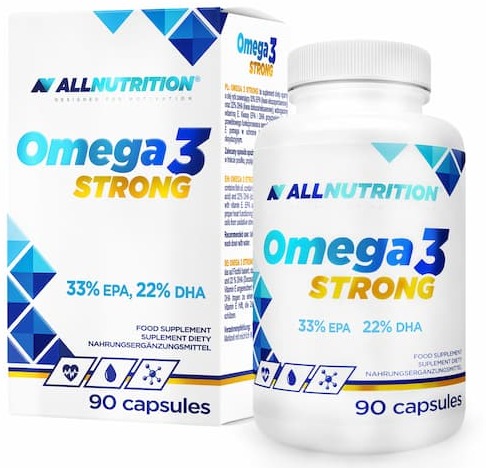
- Content omega-3 acids: 550 mg (DHA 220 mg + EPA 330 mg)
- Additional active ingredients: vitamin E
- Form: capsules .
- Dose: 1 capsule per day .
- Sufficient for: 90 days .
Product description
A dietary supplement with a solid portion of DHA and EPA – valuable for health and well-being omega-3 acidsós. Indicated especially for people on a plant-based diet, physically active people and seniors.
.The sourceóof omega-3 acids in this preparation is fish oil.
.Pros and cons
A dietary supplement with a solid portion of DHA and EPA – valuable for health and well-being omega-3 acidsós. Indicated especially for people on a plant-based diet, physically active people and seniors.
.The sourceóof omega-3 acids in this preparation is fish oil.
.Additional information
A dietary supplement with a solid portion of DHA and EPA – valuable for health and well-being omega-3 acidsós. Indicated especially for people on a plant-based diet, physically active people and seniors.
.The sourceóof omega-3 acids in this preparation is fish oil.
.User review
A dietary supplement with a solid portion of DHA and EPA – valuable for health and well-being omega-3 acidsós. Indicated especially for people on a plant-based diet, physically active people and seniors.
.The sourceóof omega-3 acids in this preparation is fish oil.
.Solgar Omega 3-6-9
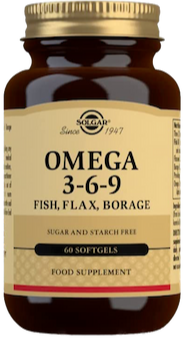
- Content of omega acids:.
- Omega-3 fatty acids.
- Omega-3 fatty acids
- alpha-linolenic acid (ALA) – 585 mg
.- eicosapentaenoic acid (EPA) – 344 mg
- docosahexaenoic acid (DHA) – 221 mg
.
- Omega-3 fatty acids
- Omega-6 fatty acids.
- linoleic acid (LA) – 598 mg .
- gamma-linolenic acid (GLA) – 274 mg .
- Omega-9 fatty acids.
- Oleic acid – 325 mg .
- Omega-3 fatty acids.
- Source of omega acids: fish oil from anchovies, mackerel, sardines, linseed oil, cucumber oil .
- Form: capsules .
- Packaging: 60 capsules .
- Daily allowance:3 capsules per day .
- Sufficient for: 20 days .
Product description
A combination of omega 3-6-9 fatty acidsós derived from fish and plants. The dietary supplement supplements essential omega fatty acids, whichóre needed for the proper functioning of many systemsóorgansóin the body.
Pros and cons
A combination of omega 3-6-9 fatty acidsós derived from fish and plants. The dietary supplement supplements essential omega fatty acids, whichóre needed for the proper functioning of many systemsóorgansóin the body.
Additional information
A combination of omega 3-6-9 fatty acidsós derived from fish and plants. The dietary supplement supplements essential omega fatty acids, whichóre needed for the proper functioning of many systemsóorgansóin the body.
A combination of omega 3-6-9 fatty acidsós derived from fish and plants. The dietary supplement supplements essential omega fatty acids, whichóre needed for the proper functioning of many systemsóorgansóin the body.
Omega + Vitamin D3 800 IU for children
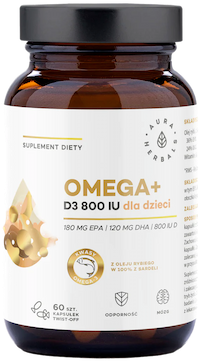
- Content of omega-3 fatty acids: 300 mg (180 mg EPA + 120 mg DHA)
- .
- Additional active ingredients: vitamin D3
- Form: twist-off capsules
- .
- Dose: 1 capsule per day
- .
- Sufficient for: 60 days
- .
Product description
Omega-3 acids for children with added vitamin D3 in good doses. The formula fills the daily requirement of EPA and DHA and vitamin D for children aged 2–18 years.
The Ministry of Health recommends supplementation with vitamin D3. In turn, omega-3 fatty acids are also crucial for the youngest.
The dietary supplement from Aura Herbals supports mós brain function, proper vision and immune system function.
The omega-3 fatty acids are derived from fish oil sourced from anchovies.
Pros and cons
Omega-3 acids for children with added vitamin D3 in good doses. The formula fills the daily requirement of EPA and DHA and vitamin D for children aged 2–18 years.
The Ministry of Health recommends supplementation with vitamin D3. In turn, omega-3 fatty acids are also crucial for the youngest.
The dietary supplement from Aura Herbals supports mós brain function, proper vision and immune system function.
The omega-3 fatty acids are derived from fish oil sourced from anchovies.
Additional information
Omega-3 acids for children with added vitamin D3 in good doses. The formula fills the daily requirement of EPA and DHA and vitamin D for children aged 2–18 years.
The Ministry of Health recommends supplementation with vitamin D3. In turn, omega-3 fatty acids are also crucial for the youngest.
The dietary supplement from Aura Herbals supports mós brain function, proper vision and immune system function.
The omega-3 fatty acids are derived from fish oil sourced from anchovies.
User review
Omega-3 acids for children with added vitamin D3 in good doses. The formula fills the daily requirement of EPA and DHA and vitamin D for children aged 2–18 years.
The Ministry of Health recommends supplementation with vitamin D3. In turn, omega-3 fatty acids are also crucial for the youngest.
The dietary supplement from Aura Herbals supports mós brain function, proper vision and immune system function.
The omega-3 fatty acids are derived from fish oil sourced from anchovies.
What alpha-linolenic acid helps with
.Although it is not entirely clear whether the health-promoting properties of alpha-linolenic acid are due to oxylipins or whether they belong to EPA, of which ALA is a precursor, there is no doubt that it positively affects the body and healthand.
Cardiovascular diseases
.The best-known benefit of consuming alpha-linolenic acid is to reduce the risk of cardiovascular disease .
Research indicates that people with higher amounts of alpha-linolenic acid in their diet (approximately 1 g per day) have a significantly lower risk of death related to cardiac dysfunction (heart attack, sudden cardiac arrest) compared to those who consume littleand. Depending on the study, this risk can decrease from a few to even tens of per cent.
Alpha-linolenic acid may also affect cholesterol levels in the body. Research suggests that increased intake of this acid may be associated with an increase in blood levels of 'good' cholesterol (HDL)and.
Inflammation
.Another factor that increases the risk of cardiovascular disease is chronic inflammation in the body. A 2023 meta-analysis indicated that alpha-linolenic acid may lower the inflammatory factor CRP in people in whom it is elevated. Interestingly, no effect of ALA supplementation was seen in people in whom this indicator was at normal levelsand.
In contrast, a 2018 research review of 25 papers by researchers suggested that ALA intake by patients with high baseline CRP levels (>6.0 mg/l) showed a beneficial effect of ALA on lowering this marker .
.The same review suggests that increasing the amount of ALA acid in the diet tends to increase blood CRP concentrations among healthy individuals .
.Excess ALA may have a pro-inflammatory effect, especially in people with autoimmune diseases such as RA or hypothyroidism or Hashimoto's..
 .
.
Julia SkrajdaDietitian
.It is also worth noting that scientists are not sure whether the cardioprotective properties of alpha-linolenic acid are not solely due to the fact that it is a precursor to the other omega-3 fatty acids (EPA and DHA). Supplementation of these nutrients also has similar effects on cardiovascular disease preventionand.
Several human studies suggest beneficial effects of consuming ALA-rich oils on the skin. In one, 45 women with sensitive and dry skin were divided into groups and consumed 2.2g of flaxseed oil or borage oil for 12 weeks in one group and a placebo in the other group. Linseed oil, rich in ALA, was shown to reduce water loss from the skin, flakiness and roughness and improve skin hydrationand.
In another study, consuming 500 mg of ALA acid after 12 weeks of use reduced water loss from the skin and redness and increased skin hydration .
Some other studies
.Today, alpha-linolenic acid is being studied for a growing number of ailments. The most contentious and controversial seems to be the effect of ALA on cancer riskand. However, there are interesting studies on other conditions.
A 2011 study of 900 participants found that increased intake of alpha-linolenic acid was associated with a reduced risk of fracture of the femoral neck by 54%and.
.Another study on the effect of ALA on bone found that the higher the concentration of this acid in the blood, the lower the risk of fractureand.
.A 2014 review identified two interesting studies suggesting a positive effect of alpha-linolenic acid intake on reducing the risk of type 2 (insulin-dependent) diabetes mellitus, conducted in Chinese and American populations.
In the first study, people consuming 1.1 g ALA per day had a 21% lower risk of type 2 diabetes than those consuming 0.27 g per day. By contrast, in a US study of seniors, higher blood concentrations of ALA phospholipids were associated with a lower risk of this disease by up to 43%and.
In 2011, the results of a decade-long study were published, in which researchers observed the incidence of coronary heart disease and stroke in relation to ALA intake in 20,000 Dutch adults. Although no association was observed between ALA intake and the incidence of ischaemic heart disease, the study showed that consumption of ALA reduced the risk of strokeand.
Sources of alpha-linolenic acid
.As you already know, you can obtain alpha-linolenic acid from plants - mainly the oils pressed from them. Here's a table-top guide with hints of the products you should be consuming:
Kale
.0.18 g
spinach
.0.14 g
|
Product . |
Alpha-linolenic acid content in 100 g |
|
Flaxseed oil . |
53.4 g |
|
Flaxseed |
22.8 g |
|
Chia seeds |
17.8 g |
|
Walnuts |
9.1 g |
|
Walnut oil |
10.4 g |
|
Rape seed oil |
9.1 g |
|
soybean oil |
6.8 g |
|
Kale |
|
|
Spinach |
|
It is recommended that ALA makes up about 0.5% of your daily food intake. In simpler terms, that's about 1.1g per day for women and 1.6g for menand. To take in the recommended portion, simply eat:
- 2-3 g of linseed oil (that's less than a teaspoon), .
- A spoonful of rapeseed oil, .
- A handful of walnuts, .
Alpha-linolenic acid deficiency
.You will notice alpha-linolenic acid deficiency mainly on the skin. It can be dry and red, and in extreme cases a deficiency of this acid can lead to dermatitis and folliculitisand.
AlA deficiency is very rare indeed. It is not worth focusing on its strict and, above all, too long and abundant supplementation. On the contrary, care should be taken not to have too much of it in our diet..
 .
.
Julia SkrajdaDietitian
.Other symptoms of ALA deficiency can beand
- disorders of motor coordination, .
- visual problems,
- disorders of vision.
- deterioration of mood, .
See also:
Summary
.- Alpha-linolenic acid is one of the three main omega-3 fatty acids.
- Alpha-linolenic acid is one of the three main omega-3 fatty acids.
- It is found in plant-based dietary sources - in particular oils.
- It is also found in plant foods.
- In the body, ALA is converted into the other omega-3 fatty acids: EPA and DHA, meaning that it may be a precursor to them.
- Alpha-linolenic acid is mainly known for its cardioprotective properties, but studies also show its positive role in preventing fractures and type 2 diabetes, as well as maintaining skin health.
- AlA deficiency is mainly reflected in the condition of the skin. It becomes dry, reddened and is more prone to inflammation.
- The skin becomes dry, reddened and more prone to inflammation.
FAQ
.Where can we find alpha-linolenic acid?
.Alpha-linolenic acid (ALA) is an omega-3 fatty acid that is essential for health, but is not produced by the body. To obtain it, you need to consume certain foods.
ALA can be found in flax seeds, linseed oil and walnuts. Linseed oil is the richest source of this acid. Add rapeseed oil to your diet as well - it is another source of alpha-linolenic acid that can be easily incorporated into your daily menu.
Alpha-linolenic acid can be found in flaxseed and walnuts.
Alpha-linolenic acid is important for heart health, the nervous system and inflammatory processes. Consume foods rich in it on a regular basis to ensure an adequate supply of ALA.
What is formed from alpha-linolenic acid?
.Alpha-linolenic acid (ALA) is converted in the body into two other important polyunsaturated fatty acids: eicosapentaenoic acid (EPA) and docosahexaenoic acid (DHA). This process is complex and involves a number of enzymatic reactions.
It is worth bearing in mind that the conversion of ALA to EPA and DHA is limited, so it is recommended to supplement the diet with products rich in EPA and DHA, such as oily fish. These omega-3 acids are crucial for brain and heart health.
Does evening primrose oil contain omega-3 fatty acids?
.Pleish oil does not contain omega-3 acids. It is a rich source of another important fatty acid - gamma-linolenic acid (GLA), which belongs to the omega-6 acid family. Use evening primrose oil for the health benefits associated with GLA, such as improving skin condition, relieving PMS symptoms and supporting heart health.
If you are looking for a source of omega-3 fatty acids, choose oils such as flaxseed, rapeseed or seaweed oil. These fatty acids are essential for brain and heart health. Balance your intake of omega-6 and omega-3. An excess of omega-6 in your diet can lead to inflammation. Therefore, if you use evening primrose oil, add omega-3 sources to your diet as well.
What is the most alpha-linolenic acid in?
.The most alpha-linolenic acid (ALA) can be found in flax seeds. Include them in your diet, for example by adding them to your morning oatmeal or smoothie. ALA is also abundant in rapeseed oil, which can be used in cooking or as a salad dressing. Include walnuts in your diet, which are another source of ALA. Why it's important. ALA is an essential omega-3 fatty acid that the body cannot make on its own, and which is crucial for heart and brain health.
How much alpha-linolenic acid per day?
.The daily recommended intake of alpha-linolenic acid ranges from 1.1 (for women) to 1.6 g (for men). ALA is an essential omega-3 fatty acid, which means it must be supplied with the diet. It can be found in products such as flaxseed, walnuts and rapeseed oil.
Why is it important? ALA is a precursor for other omega-3 fatty acids, which are crucial for heart and brain health. For example, 30g of walnuts contains approximately 2.5g of ALA.
Is ALA acid an omega-3?
.There are two substances that are referred to as ALA acid. The first is alpha-lipoic acid - this, although an important antioxidant for the body, is not part of the omega-3 acids. The other is alpha-linolenic acid, which belongs to the omega-3 family of polyunsaturated fatty acids.
What is better: flaxseed oil or nigella oil?
.Choosing between flaxseed oil and black cumin oil depends on your individual health needs.
Choose flaxseed oil if you want to increase your intake of omega-3 fatty acids. It is rich in alpha-linolenic acid (ALA), which is a precursor to EPA and DHA, the other two omega-3 fatty acids. ALA helps to reduce inflammation and may support heart health.
On the other hand, black cumin oil is known for its powerful antioxidant and anti-inflammatory properties. It is rich in substances that may have potential anti-cancer properties.
Finally, the choice depends on your health goal. You can also consider using both oils.
Sources
.See all
.Alpha-linolenic acid Information | Mount Sinai-New York. (n.d.). Mount Sinai Health System. Retrieved December 4, 2023, from https://www.mountsinai.org/health-library/supplement/alpha-linolenic-acid
Bjerve, K. S., Fischer, S., Wammer, F., & Egeland, T. (1989a). alpha-Linolenic acid and long-chain omega-3 fatty acid supplementation in three patients with omega-3 fatty acid deficiency: Effect on lymphocyte function, plasma and red cell lipids, and prostanoid formation. The American Journal of Clinical Nutrition, 49(2), 290-300. https://doi.org/10.1093/ajcn/49.2.290
Bjerve, K. S., Thoresen, L., Mostad, I. L., & Alme, K. (1987). Alpha-linolenic acid deficiency in man: Effect of essential fatty acids on fatty acid composition. Advances in Prostaglandin, Thromboxane, and Leukotriene Research, 17B, 862-865. https://pubmed.ncbi.nlm.nih.gov/2890285/
.Brenna, J. T. (2002). Efficiency of conversion of alpha-linolenic acid to long chain n-3 fatty acids in man. Current Opinion in Clinical Nutrition and Metabolic Care, 5(2), 127-132. https://doi.org/10.1097/00075197-200203000-00002
Burdge, G. C., & Calder, P. C. (2006). Dietary α-linolenic acid and health-related outcomes: A metabolic perspective. Nutrition Research Reviews, 19(1), 26-52. https://doi.org/10.1079/NRR2005113
Cambiaggi, L., Chakravarty, A., Noureddine, N., & Hersberger, M. (2023). The Role of α-Linolenic Acid and Its Oxylipins in Human Cardiovascular Diseases. International Journal of Molecular Sciences, 24(7), Article 7. https://doi.org/10.3390/ijms24076110
Chen, L.-H., Hu, Q., Li, G., Zhang, L., Qin, L.-Q., Zuo, H., & Xu, G. (2021). Dietary Intake and Biomarkers of α-Linolenic Acid and Mortality: A Meta-Analysis of Prospective Cohort Studies. Frontiers in Nutrition, 8. https://www.frontiersin.org/articles/10.3389/fnut.2021.743852
.de Goede, J., Verschuren, W. M. M., Boer, J. M. A., Kromhout, D., & Geleijnse, J. M. (2011). Alpha-linolenic acid intake and 10-year incidence of coronary heart disease and stroke in 20,000 middle-aged men and women in the Netherlands. PloS One, 6(3), e17967. https://doi.org/10.1371/journal.pone.0017967
De Spirt, S., Stahl, W., Tronnier, H., Sies, H., Bejot, M., Maurette, J.-M., & Heinrich, U. (2009). Intervention with flaxseed and borage oil supplements modulates skin condition in women. The British Journal of Nutrition, 101(3), 440-445. https://doi.org/10.1017/S0007114508020321
Delion, S., Chalon, S., Hérault, J., Guilloteau, D., Besnard, J.-C., & Durand, G. (1994). Chronic Dietary α-Linolenic Acid Deficiency Alters Dopaminergic and Serotoninergic Neurotransmission in Rats1,23. The Journal of Nutrition, 124(12), 2466-2476. https://doi.org/10.1093/jn/124.12.2466
Farina, E. K., Kiel, D. P., Roubenoff, R., Schaefer, E. J., Cupples, L. A., & Tucker, K. L. (2011). Dietary Intakes of Arachidonic Acid and α-Linolenic Acid Are Associated with Reduced Risk of Hip Fracture in Older Adults12. The Journal of Nutrition, 141(6), 1146-1153. https://doi.org/10.3945/jn.110.133728
Harris, W. S. (2005). Alpha-Linolenic Acid. Circulation, 111(22), 2872-2874. https://doi.org/10.1161/CIRCULATIONAHA.105.545640
Li, J., Gu, Z., Pan, Y., Wang, S., Chen, H., Zhang, H., Chen, W., & Chen, Y. Q. (2017). Dietary supplementation of α-linolenic acid induced conversion of n-3 LCPUFAs and reduced prostate cancer growth in a mouse model. Lipids in Health and Disease, 16(1), 136. https://doi.org/10.1186/s12944-017-0529-z
Naghshi, S., Aune, D., Beyene, J., Mobarak, S., Asadi, M., & Sadeghi, O. (2021). Dietary intake and biomarkers of alpha linolenic acid and risk of all-cause, cardiovascular, and cancer mortality: Systematic review and dose-response meta-analysis of cohort studies. BMJ, 375, n2213. https://doi.org/10.1136/bmj.n2213
Neukam, K., De Spirt, S., Stahl, W., Bejot, M., Maurette, J.-M., Tronnier, H., & Heinrich, U. (2011). Supplementation of flaxseed oil diminishes skin sensitivity and improves skin barrier function and condition. Skin Pharmacology and Physiology, 24(2), 67-74. https://doi.org/10.1159/000321442
Rajaram, S. (2014). Health benefits of plant-derived α-linolenic acid123. The American Journal of Clinical Nutrition, 100, 443S-448S. https://doi.org/10.3945/ajcn.113.071514
The review of alpha-linolenic acid: Sources, metabolism, and pharmacology. (n.d.). https://doi.org/10.1002/ptr.7295
Trumbo, P., Schlicker, S., Yates, A. A., Poos, M., & Food and Nutrition Board of the Institute of Medicine, The National Academies. (2002). Dietary reference intakes for energy, carbohydrate, fiber, fat, fatty acids, cholesterol, protein and amino acids. Journal of the American Dietetic Association, 102(11), 1621-1630. https://doi.org/10.1016/s0002-8223(02)90346-9
Wawryszuk, N. (2023). Omega acids. Everything you need to know. (B. Turczynski, Ed.; 1st ed.). Natu.Care. https://books.google.com/books?vid=9788396887818
.Editorials
Meet the team



Omega-3 fatty acids are a useful dietary supplement for active people - improves performance and fitness.
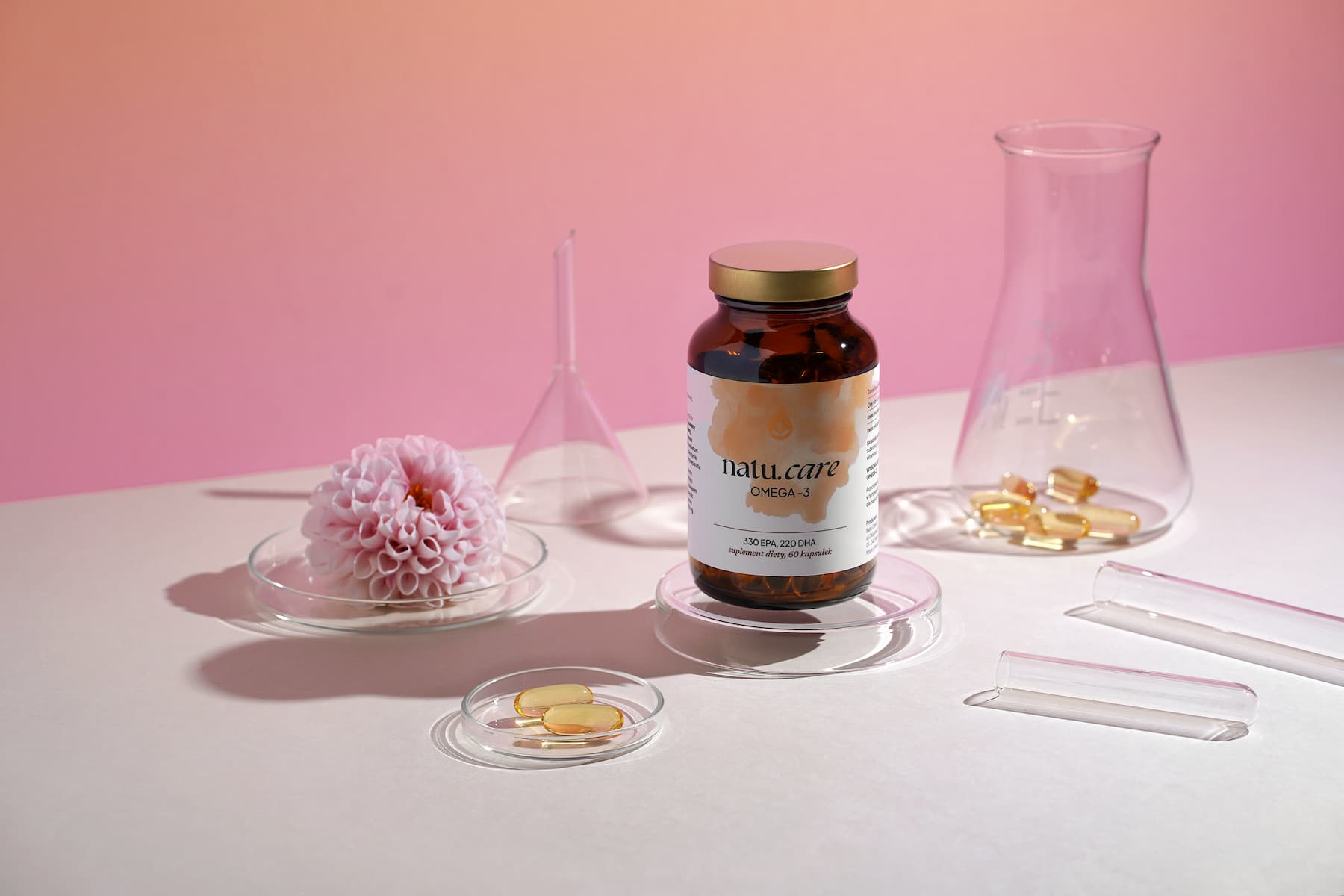
Omega-3 in a good dose and an optimum ratio of DHA and EPA acids will replenish valuable fats in the diet.
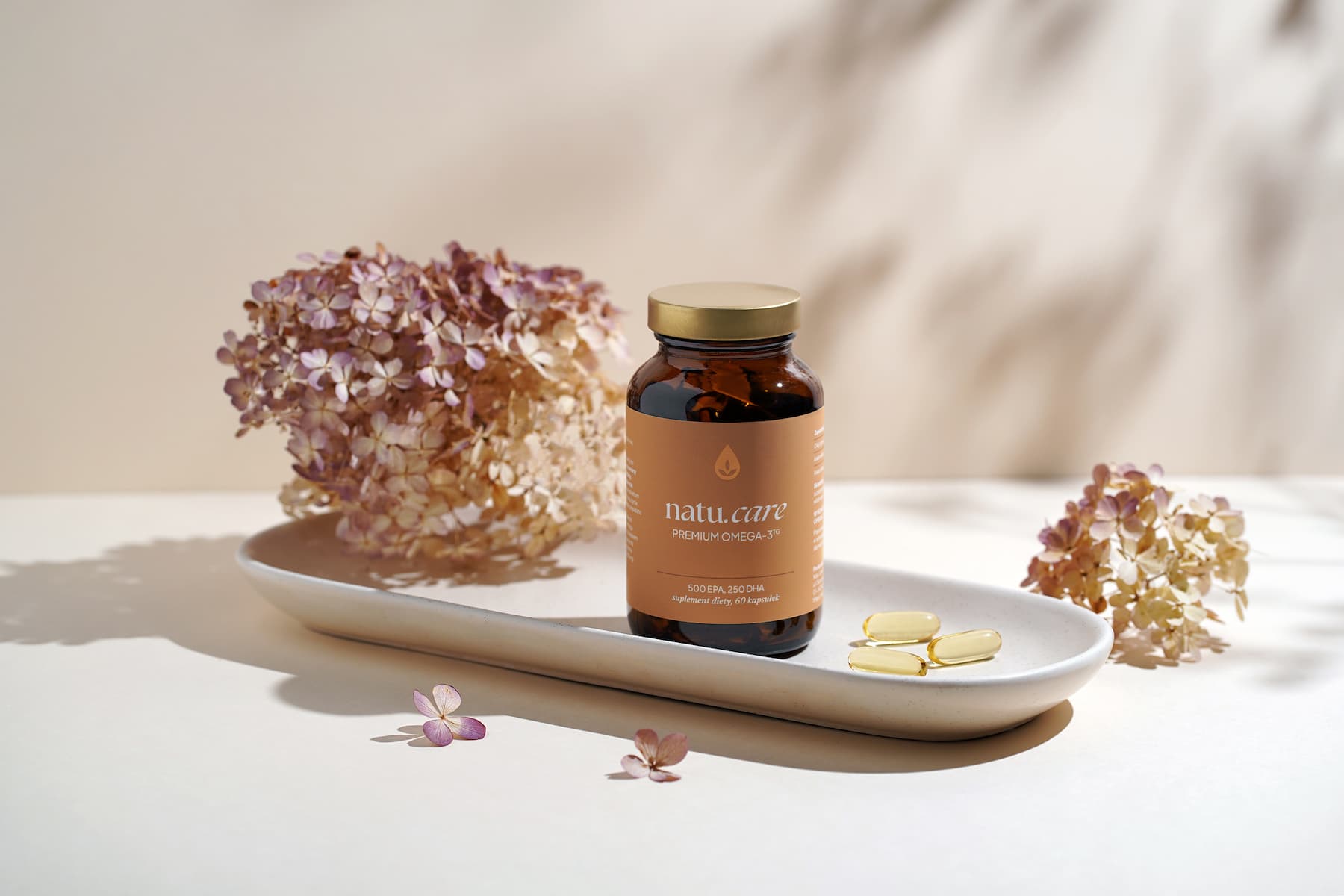
The omega-3 acids from Natu.Care are distinguished by their triglyceride form, which is characterised by high bioavailability.
